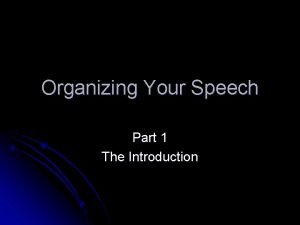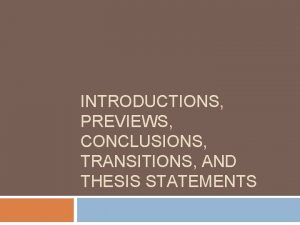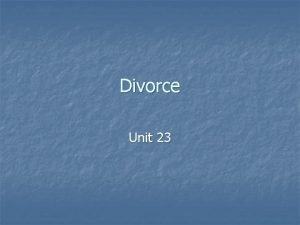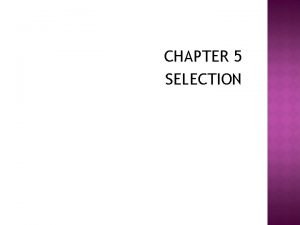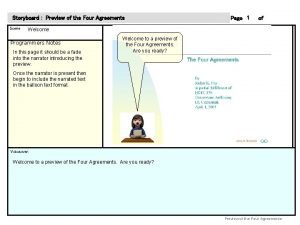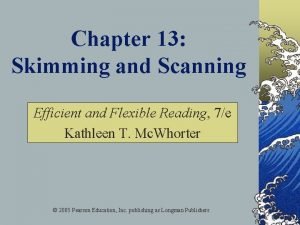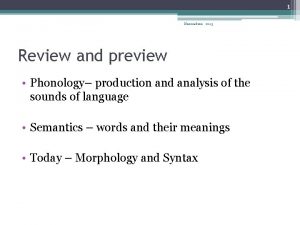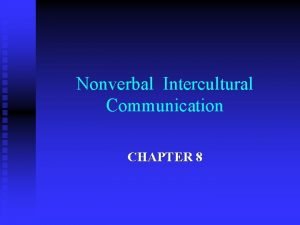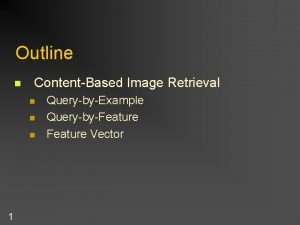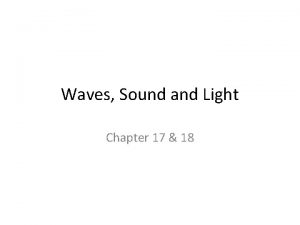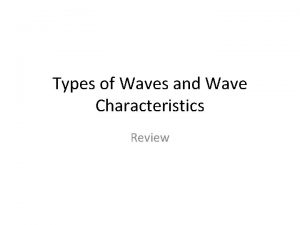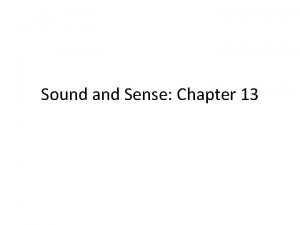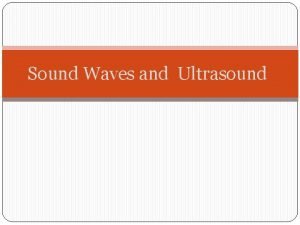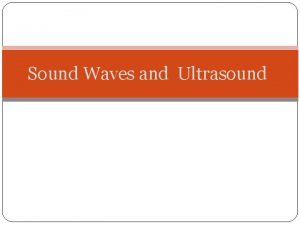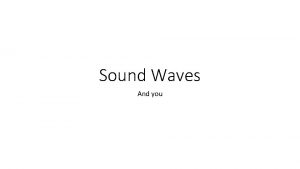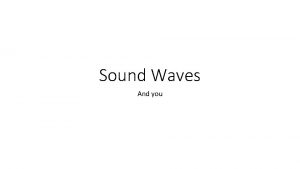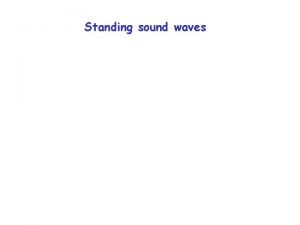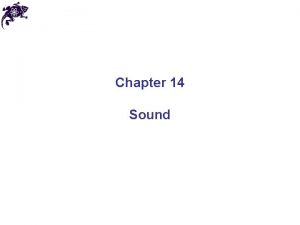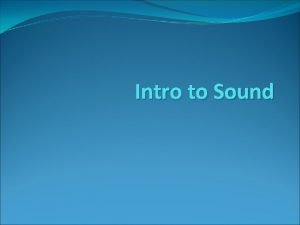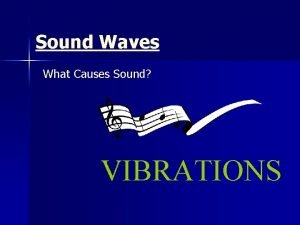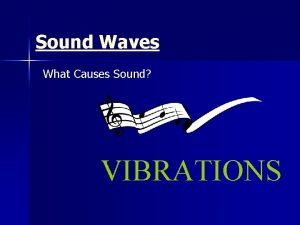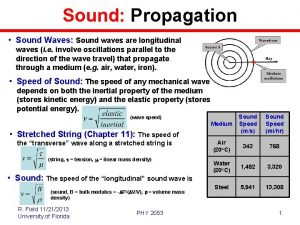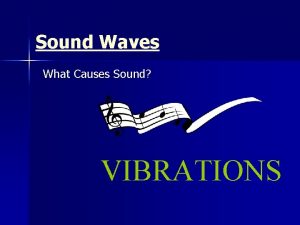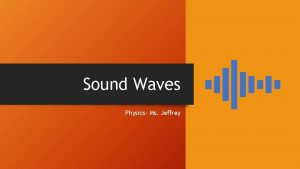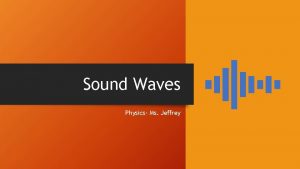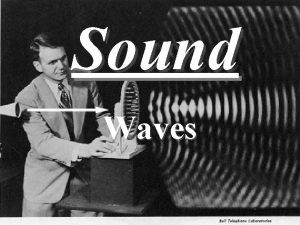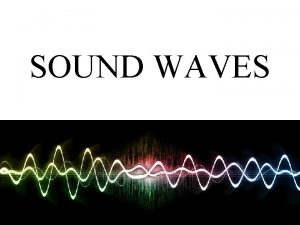Sound Preview Section 1 Sound Waves Section 2

















































- Slides: 49

Sound Preview Section 1 Sound Waves Section 2 Sound Intensity and Resonance Section 3 Harmonics © Houghton Mifflin Harcourt Publishing Company Section 1

Sound Section 1 What do you think? • What is sound? • What do all of the sounds that you hear have in common? • How do they differ? • Can sounds travel through solids? Liquids? Gases? • Is one type of material better for transmitting sound waves? • When race cars or emergency vehicles pass you, the sound changes. In what way, and why? © Houghton Mifflin Harcourt Publishing Company

Sound What is Sound? • Sound is a longitudinal wave. • All sound waves are produced by vibrating objects. – Tuning forks, guitar strings, vocal cords, speakers • The vibrating object pushes the air molecules together, forming a compression. • It then spreads them apart, forming a rarefaction. © Houghton Mifflin Harcourt Publishing Company Section 1

Sound Section 1 Graphing Sound Waves • The diagram shows compressions (dark) and rarefactions(white). If you measured the pressure or density of the air and plotted these against position, how would the graph appear? © Houghton Mifflin Harcourt Publishing Company

Sound Section 1 Sound Waves Click below to watch the Visual Concept © Houghton Mifflin Harcourt Publishing Company

Sound Section 1 Characteristics of Sound • Frequency is the number of waves per second. • You have heard of ultrasound. What is it? • Frequencies audible to humans are between 20 Hz and 20 000 Hz. – Middle C on a piano is 262 Hz. – The emergency broadcast signal is 1 000 Hz. • Infrasound frequencies are lower than 20 Hz. • Ultrasound frequencies are greater than 20 000 Hz. © Houghton Mifflin Harcourt Publishing Company

Sound Section 1 Comparing Infrasonic and Ultrasonic Sounds Click below to watch the Visual Concept © Houghton Mifflin Harcourt Publishing Company

Sound Section 1 Pitch • Pitch is the human perception of how high or low a sound appears to be. – Pitch is primarily determined by frequency. – Pitch also depends slightly on other factors. • Higher frequencies appear to have a higher pitch when played loudly, even though the frequency does not change. © Houghton Mifflin Harcourt Publishing Company

Sound Section 1 Speed of Sound • Sound waves travel though solids, liquids and gases. – In which would the speed generally be greatest? Why? • Solids. Because the molecules are more closely packed, the particles respond more rapidly to compressions. – How might the temperature of air affect the speed of sound waves? Why? • Higher temperature increases the speed of the waves because the particles are moving faster and colliding more often. © Houghton Mifflin Harcourt Publishing Company

Sound Speed of Sound © Houghton Mifflin Harcourt Publishing Company Section 1

Sound Section 1 Spherical Waves • Sound propagates in three dimensions. • The diagram shows: – Crests or wave fronts (blue circles) – Wavelength ( ) – Rays (red arrows) • Rays indicate the direction of propagation. • How would these wave fronts appear different if they were much farther from the source? © Houghton Mifflin Harcourt Publishing Company

Sound Section 1 Spherical Waves • Wave fronts and rays become more nearly parallel at great distances. • Plane waves are simply very small segments of a spherical wave a long distance from the source. © Houghton Mifflin Harcourt Publishing Company

Sound Section 1 Doppler Effect • Why are the waves closer together on the left? – Waves are closer because the vehicle moves to the left along with the previous wave. • How will the sound be different for observer A and observer B? – Higher frequency (pitch) for observer A • Continued on the next slide…. © Houghton Mifflin Harcourt Publishing Company

Sound Section 1 Doppler Effect • How would the wave pattern change if the vehicle moved at a faster speed? How would it sound different? – At a higher speed, waves would be even closer together and the pitch difference would be even greater. • The Doppler effect is the observed change in frequency due to the motion of the source or observer. © Houghton Mifflin Harcourt Publishing Company

Sound Section 1 Doppler Effect and Sound Click below to watch the Visual Concept © Houghton Mifflin Harcourt Publishing Company

Sound Section 1 Now what do you think? • What is sound? – What do all of the sounds that you hear have in common? – How do they differ? • Can sounds travel through solids? Liquids? Gases? – Is one type of material better for transmitting sound waves? • When race cars or emergency vehicles pass you, the sound changes. In what way, and why? © Houghton Mifflin Harcourt Publishing Company

Sound Section 2 What do you think? • Members of rock bands generally protect their ears from the loud sounds to prevent damage to their hearing. • How do we determine the loudness of a sound? • What quantity is loudness measuring? • What units are used? • Name three ways you can reduce the loudness of the music heard by a person in the audience. © Houghton Mifflin Harcourt Publishing Company

Sound Section 2 Sound Intensity • Vibrating objects do work on the air as they push against the molecules. • Intensity is the rate of energy flow through an area. – What is “rate of energy flow” called? • E/t is called power (P). – Since the waves spread out spherically, you must calculate the area of a sphere. How? • A = 4 r 2 – So, what is the equation for intensity? © Houghton Mifflin Harcourt Publishing Company

Sound Section 2 Sound Intensity • SI unit: W/m 2 • This is an inverse square relationship. – Doubling r reduces intensity by ¼. – What happens if r is halved? • Intensity increases by a factor of 4. © Houghton Mifflin Harcourt Publishing Company

Sound Section 2 Intensity and Decibels • An intensity scale based on human perception of loudness is often used. • The base unit of this scale is the bel. More commonly, the decibel (d. B) is used. – 0. 1 bel = 1 d. B, 1 bel = 10 d. B, 5 bels = 50 d. B, etc. – The lowest intensity humans hear is assigned a value of zero. • The scale is logarithmic, so each increase of 1 bel is 10 times louder. – An increase in intensity of 3 bels is 1 000 times louder. © Houghton Mifflin Harcourt Publishing Company

Sound © Houghton Mifflin Harcourt Publishing Company Section 2

Sound Section 2 Classroom Practice Problems • The intensity of the sound from an explosion is 0. 10 W/m 2 at a distance of 1. 0 × 103 m. Find the intensity of the sound at a distance of 5. 0 × 102 m, 1. 0 × 102 m and 10. 0 m. – Answers: 0. 41 W/m 2, 1. 0 × 103 W/m 2 • Find the approximate decibel equivalents of these sound intensities using Table 2. – Answers: 110 d. B, 130 d. B, 150 d. B © Houghton Mifflin Harcourt Publishing Company

Sound Section 2 Audible Sounds • The softest sound humans can hear is called the threshold of hearing. – Intensity = 1 10 -12 W/m 2 or zero d. B • The loudest sound humans can tolerate is called the threshold of pain. – Intensity = 1. 0 W/m 2 or 120 d. B • Human hearing depends on both the frequency and the intensity. © Houghton Mifflin Harcourt Publishing Company

Sound © Houghton Mifflin Harcourt Publishing Company Section 2

Sound Section 2 Human Hearing Click below to watch the Visual Concept © Houghton Mifflin Harcourt Publishing Company

Sound Section 2 Forced Vibrations • Sympathetic vibrations occur when a vibrating object forces another to vibrate as well. – A piano string vibrates the sound board. – A guitar string vibrates the bridge. • This makes the sound louder and the vibrations die out faster. – Energy is transferred from the string to the sound board or bridge. © Houghton Mifflin Harcourt Publishing Company

Sound Section 2 Resonance • The red rubber band links the 4 pendulums. • If a blue pendulum is set in motion, only the other blue pendulum will have largeamplitude vibrations. – The others will just move a small amount. • Since the vibrating frequencies of the blue pendulums match, they are resonant. © Houghton Mifflin Harcourt Publishing Company

Sound Section 2 Resonance • Large amplitude vibrations produced when the frequency of the applied force matches the natural frequency of receiver – One blue pendulum was the driving force and the other was the receiver. • Bridges have collapsed as a result of structural resonance. – Tacoma Narrows in the wind – A freeway overpass during an earthquake © Houghton Mifflin Harcourt Publishing Company

Sound Section 2 Resonance (Frequency) Click below to watch the Visual Concept © Houghton Mifflin Harcourt Publishing Company

Sound Section 2 Now what do you think? • Members of rock bands generally protect their ears from the loud sounds to prevent damage to their hearing. – How do we determine the loudness of a sound? • What quantity is loudness measuring? • What units are used? – Name three ways you can reduce the loudness of the music heard by a person in the audience. © Houghton Mifflin Harcourt Publishing Company

Sound Section 3 What do you think? • A violin, a trumpet, and a clarinet all play the same note, a concert A. However, they all sound different. • What is the same about the sound? • Are the frequencies produced the same? • Are the wave patterns the same? • Why do the instruments sound different? © Houghton Mifflin Harcourt Publishing Company

Sound Standing Waves on a String • There is a node at each end because the string is fixed at the ends. • The diagram shows three possible standing wave patterns. • Standing waves are produced by interference as waves travel in opposite directions after plucking or bowing the string. • The lowest frequency (one loop) is called the fundamental frequency (f 1). © Houghton Mifflin Harcourt Publishing Company Section 3

Sound Section 3 Standing Waves on a String • To the left is a snapshot of a single loop standing wave on a string of length, L. • What is the wavelength for this wave? – Answer: = 2 L • What is the frequency? – Answer: © Houghton Mifflin Harcourt Publishing Company

Sound © Houghton Mifflin Harcourt Publishing Company Section 3

Sound Section 3 Harmonics • n is the number of loops or harmonic number. • v is the speed of the wave on the string. – Depends on tension and density of the string • L is the length of the vibrating portion of the string. • How could you change the frequency (pitch) of a string? © Houghton Mifflin Harcourt Publishing Company

Sound Section 3 Fundamental Frequency Click below to watch the Visual Concept © Houghton Mifflin Harcourt Publishing Company

Sound Section 3 Standing Waves in an Air Column • Wind instruments also use standing waves. – Flutes, trumpets, pipe organs, trombones, etc. • Some instruments have pipes open at both ends while others have one end closed. – Air is free to move at open ends so antinodes occur. – Closed ends are nodes. • The velocity of the wave is now the velocity of sound in air (346 m/s at 25°C). © Houghton Mifflin Harcourt Publishing Company

Sound Both Ends Open © Houghton Mifflin Harcourt Publishing Company Section 3

Sound Closed at One End © Houghton Mifflin Harcourt Publishing Company Section 3

Sound Section 3 Wind Instruments • Wind instruments are not as simple as organ pipes. – The shape is not always cylindrical. – The holes change the wave patterns as well. – The size of the “pipe” varies along the length. © Houghton Mifflin Harcourt Publishing Company

Sound Section 3 Classroom Practice Problems • One string on a toy guitar is 34. 5 cm long. – What is the wavelength of the first harmonic or the fundamental wavelength? • Answer: 69. 0 cm or 0. 690 m – The string is plucked and the speed of the waves on the string is 410 m/s. What are the frequencies of the first three harmonics? • 590 Hz, 1200 Hz, 1800 Hz • Note: The use of significant figures causes the multiples of 590 to be 1200 and 1800 because only two significant figures are present in the answer. © Houghton Mifflin Harcourt Publishing Company

Sound Section 3 Classroom Practice Problems • An organ pipe open at both ends is 34. 5 cm long. – What is the wavelength of the first harmonic or the fundamental wavelength? • Answer: 69. 0 cm or 0. 690 m – What are the frequencies of the first three harmonics if the air temperature is 25. 0°C? • Answers: 501 Hz, 1000 Hz, 1500 Hz – Answer the same questions if the pipe is closed at one end. • Answers: 251 Hz, 753 Hz, 1250 Hz © Houghton Mifflin Harcourt Publishing Company

Sound Section 3 Timbre or Quality of Sound • Instruments do not vibrate in a single mode. – Several harmonics are produced at the same time. – The particular harmonics and intensity of each vary with different instruments. • Timbre is the quality of the tone resulting from the combination of harmonics. • The fundamental frequency (1 st harmonic) determines the pitch. – Adding other harmonics changes the timbre. © Houghton Mifflin Harcourt Publishing Company

Sound Timbre © Houghton Mifflin Harcourt Publishing Company Section 3

Sound Section 3 Timbre Click below to watch the Visual Concept © Houghton Mifflin Harcourt Publishing Company

Sound Beats • The diagram shows two waves of different frequencies. Sketch the superposition or sum of these waves. • How would the combined wave sound? © Houghton Mifflin Harcourt Publishing Company Section 3

Sound Section 3 Beats • Produced by two waves with the same intensity and different frequencies – Generally the frequencies are nearly the same. • The sound pulses or changes from loud to soft and back. • Beats are used to tune instruments. – If a tuner hears beats, the instruments are slightly out of tune. • The number of beats heard per second is the difference in the two frequencies. © Houghton Mifflin Harcourt Publishing Company

Sound Section 3 Beat Click below to watch the Visual Concept © Houghton Mifflin Harcourt Publishing Company

Sound Section 3 Now what do you think? • A violin, a trumpet, and a clarinet all play the same note, a concert A. However, they all sound different. – What is the same about the sound? • Are the frequencies produced the same? • Are the wave patterns the same? – Why do the instruments sound different? © Houghton Mifflin Harcourt Publishing Company
 Transverse wave vs longitudinal wave
Transverse wave vs longitudinal wave Transfer of energy when a wave disappears into a surface
Transfer of energy when a wave disappears into a surface What type of waves are sound waves? *
What type of waves are sound waves? * Is echolocation transverse or longitudinal
Is echolocation transverse or longitudinal Similarities of mechanical waves and electromagnetic waves
Similarities of mechanical waves and electromagnetic waves Mechanical waves and electromagnetic waves
Mechanical waves and electromagnetic waves Carbon dioxide temperature
Carbon dioxide temperature Difference between matter waves and electromagnetic waves
Difference between matter waves and electromagnetic waves Examples of mechanical and electromagnetic waves
Examples of mechanical and electromagnetic waves Mechanical waves and electromagnetic waves similarities
Mechanical waves and electromagnetic waves similarities Seismic waves
Seismic waves Is a seismic wave mechanical or electromagnetic
Is a seismic wave mechanical or electromagnetic Compare and contrast p waves and s waves using venn diagram
Compare and contrast p waves and s waves using venn diagram Mechanical waves vs electromagnetic waves venn diagram
Mechanical waves vs electromagnetic waves venn diagram Aimtoknow
Aimtoknow What is thesis statement example
What is thesis statement example Summary thesis statement
Summary thesis statement Test prep preview
Test prep preview Test prep preview
Test prep preview Test prep preview
Test prep preview Test prep preview
Test prep preview Sccm technical preview
Sccm technical preview Preview statement speech example
Preview statement speech example What is a preview statement
What is a preview statement Test prep preview
Test prep preview Nnn preview
Nnn preview The selection preview
The selection preview Chapter 21 standardized test practice answers
Chapter 21 standardized test practice answers The four agreements preview
The four agreements preview Test prep preview
Test prep preview Perintah print preview kita jalankan dari menu
Perintah print preview kita jalankan dari menu Realistic job preview advantages and disadvantages
Realistic job preview advantages and disadvantages Test prep preview
Test prep preview Skimming newspaper
Skimming newspaper 1984 book preview
1984 book preview Yandex film ru
Yandex film ru Nút lệnh print preview nằm ở đâu
Nút lệnh print preview nằm ở đâu Tams college acceptance
Tams college acceptance Review and preview
Review and preview Benefits of hr forecasting
Benefits of hr forecasting Disadvantages of realistic job preview
Disadvantages of realistic job preview Preview of main points
Preview of main points Preview speech
Preview speech Preview of main points
Preview of main points Nnn image preview
Nnn image preview Cara menampilkan preview file di windows 10
Cara menampilkan preview file di windows 10 Characteristics of mechanical waves
Characteristics of mechanical waves Sound waves from a radio generally travel in which medium?
Sound waves from a radio generally travel in which medium? Spelling shed
Spelling shed Onomatopoeia words
Onomatopoeia words






















